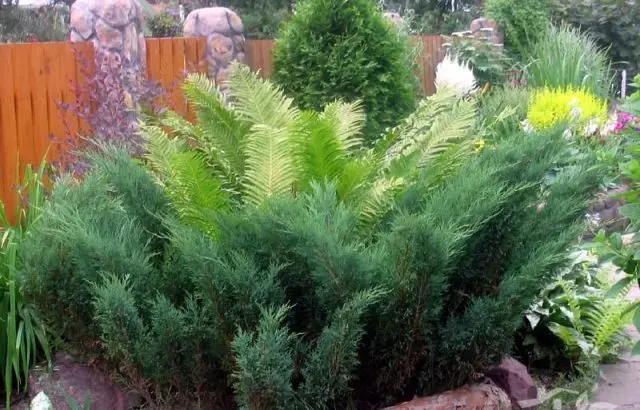Contents
- Description of juniper Cossack
- Varieties of juniper Cossack
- Juniper Cossack in landscape design
- Conditions for growing juniper Cossack
- Planting and caring for Cossack juniper
- What to plant next to the Cossack juniper
- Flowering juniper Cossack
- How to propagate Cossack juniper
- Pests and diseases of the Cossack juniper
- Conclusion
- Reviews about juniper Cossack
There are about 70 species of juniper distributed in the Northern Hemisphere from the Arctic to the equator. For most of them, the range is limited to a certain mountain system or region, only a few can be found in the wild over a large area. Juniper Cossack refers specifically to the widespread species. It grows in Asia Minor and Southeast, Central and Southern Europe, Siberia, Primorye, the Urals, the Caucasus, and southern Ukraine. The culture forms thickets in forests and groves at an altitude of 1 to 3 thousand meters.
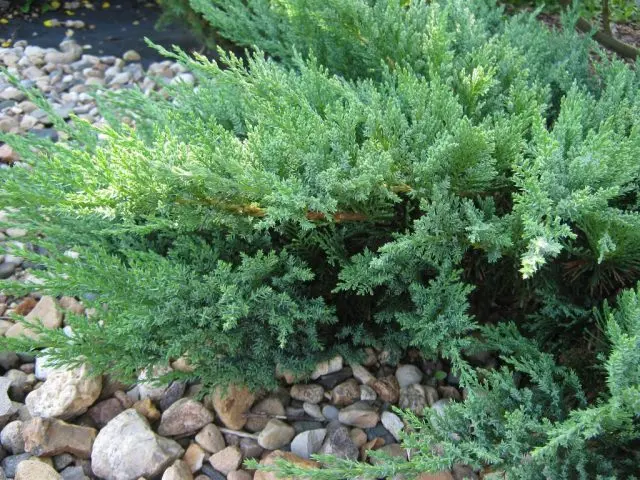
Description of juniper Cossack
Juniper Cossack (Juniperus sabina) belongs to the genus Juniper from the Cypress family. It is a shrub up to 4,5 m, but more often not exceeding 1,5 m in size. When describing the characteristics of the Cossack juniper, it would be correct to speak not about the height of the plant, but about the length of the skeletal branches.
Its crown is formed by obliquely located trunks, heavily overgrown with lateral shoots. The branches are more or less trailing, but the ends are usually raised and directed upwards. The diameter of young green shoots is about 1 mm. Often branches grow to the ground and form thickets. Therefore, it is problematic to talk about the crown diameter of the Cossack juniper. In the intertwining of thick, lying on the ground and constantly rooting branches, it is difficult to distinguish where one plant ends and another begins.
The bark exfoliates, the old one falls off, painted in a reddish-brown color. The wood is soft but durable, with a strong, not too pleasant smell, caused by the high content of essential oils.
The needles on young and shaded plants are sharp, erect, wrinkled, bluish-green, with a distinct central vein. Its length is 4 mm.
With age, the needles become shorter, scaly, to the touch – much softer and non-thorny. It is located oppositely, on the main branches it is longer than on the lateral shoots – 3 and 1 mm, respectively.
Cossack juniper needles live for three years. They have a rather strong unpleasant odor that spreads when rubbed.
Cossack juniper is resistant to low temperatures, anthropogenic pollution, shading and drought, undemanding to soils. The root system is powerful, goes deep into the ground. Life span is about 500 years.
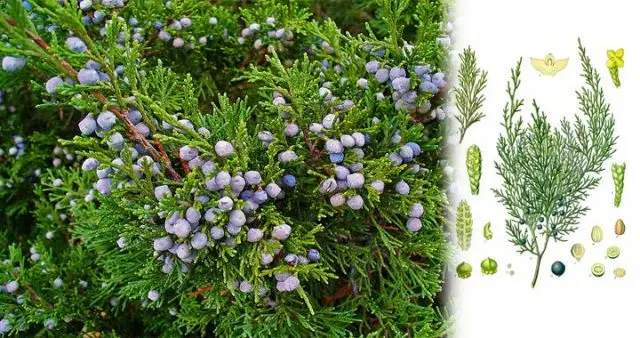
Varieties of juniper Cossack
In culture, the Cossack juniper has been known since 1584, first described by Carl Linnaeus in 1753. It is widely used due to its unpretentiousness, decorativeness and ability to heal the air. Over four and a half centuries, many varieties have been created that can satisfy a wide variety of tastes.
Juniper Cossack Mas
Variety Mas differs from others in raised shoots with slightly drooping tips. The crown is dense, spreading, up to 3 m in diameter, in an adult plant it looks like a funnel. Since the branches are directed upwards, they take root on their own less often than in other varieties. The height of the juniper Cossack Mas reaches 1,5, sometimes 2 meters, the annual growth is 8-15 cm.
Young needles are prickly, with age at the ends of the shoots it becomes scaly, inside the bush it remains sharp. On the side facing the sun, the Cossack juniper is bluish, below it is dark green. In winter, the color changes, and acquires a purple hue.
Single cones are formed only on old bushes. The bark is reddish, the root is powerful. Prefers a sunny location, but tolerates partial shade. Frost resistance – zone 4.
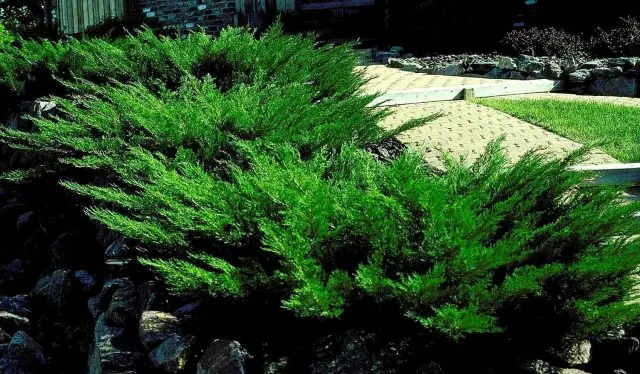
Juniper Cossack Knap Hill
Knap Hill variety is considered one of the most beautiful. It is distinguished by a rather compact crown – an adult plant reaches a height of 1,5 m with a diameter of 1,6 m. By the age of 10, the dimensions are 0,7-1 and 1-1,2 m, respectively.
The needles are beautiful green, young – needle-shaped. An adult bush can have two varieties at the same time – soft scaly and prickly. Cone berries are formed only on adult specimens, painted in dark brown color, covered with a bluish wax coating.
This variety is quite shade-tolerant, but looks more attractive in the open. Winters without shelter in zone four.
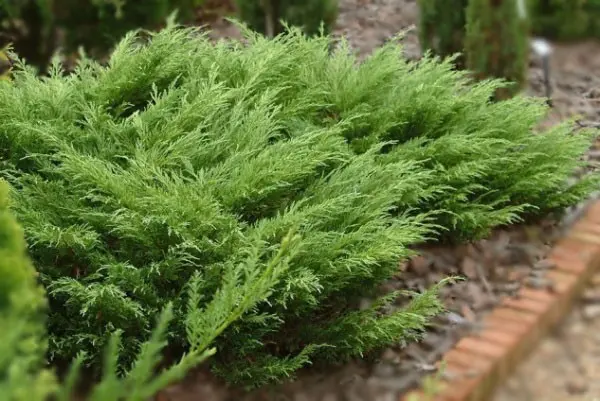
Juniper Cossack Arcadia
The slow-growing Arcadia variety is at the same time one of the most resistant to low temperatures. Without shelter, grows in zone 2. Does not tolerate overflows and saline soil, prefers placement in a sunny place. In general, it is considered a very hardy variety to adverse conditions.
Seedlings of the Cossack juniper Arcadia grew from seeds obtained from the Urals in the American nursery of D. Hill. Work on the variety was carried out from 1933 to 1949, when it was registered.
The height of the Cossack juniper Arkady at 10 years old is only 30-40 cm, while the branches are mastering by this time an area with a diameter of 1,8 m and are located almost horizontally. They form a uniform, not too dense cover. An adult bush stretches branches to a height of 0,5 m and covers 2 m.
In a young plant, the needles are prickly, needle-shaped. It becomes softer with age. The color of the vegetative organs is green, sometimes with a bluish or bluish tint. The variety is considered one of the slowest growing Cossack junipers.
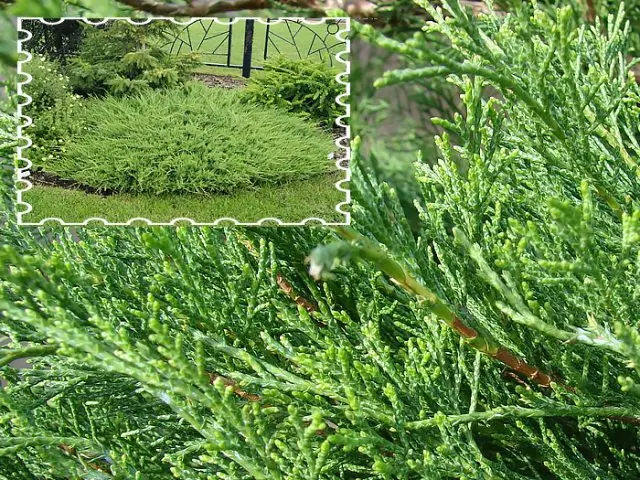
Juniper Cossack Glauka
As the name implies, this variety of Cossack juniper is distinguished by blue needles. It will be especially bright in the sun, while in partial shade the vegetative organs will become green, and the branches will become loose. But only the decorativeness of the plant will suffer, and not health.
Cossack juniper Glauka is considered fast-growing. Its branches spread along the ground, grow and quickly form an extensive colony. At the same time, the beautiful shape of the bush is deformed, lost among the many tangled and intersecting shoots. So, if the design of the site does not require the creation of thickets, the branches must be monitored to prevent rooting.
Glauka grows up to 1,5 m in height, spreading in breadth by 4 m.
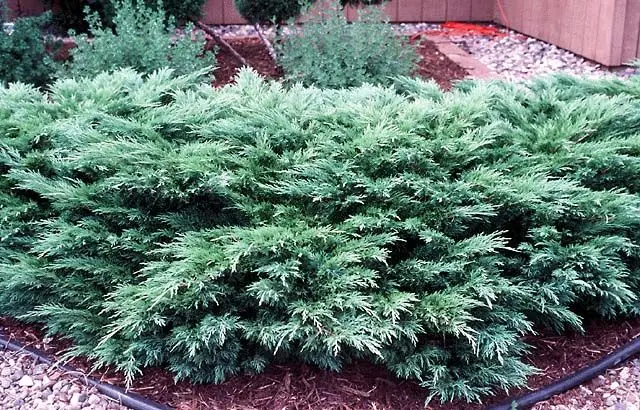
Juniper Cossack Rockery Jam
From English, the name of the variety of Cossack juniper Rockery Gem is translated as the Pearl of Rockery. It was isolated at the beginning of the last century in the branch of the Boskop nursery Le Febre. The variety is considered an improved and ennobled version of the Cossack juniper Tamariscifolia.
Rockery Jam is a dense dwarf shrub with a beautifully shaped open crown. The branches are raised to a height of about 50 cm, the diameter of an adult plant is 3,5 m. This Cossack juniper forms flat dense thickets and can be used as a ground cover plant.
The culture grows slowly, it is distinguished by bluish-green needles. On young and adult bushes, the leaves are prickly, collected in whorls of 3 pieces.
The variety prefers a location in partial shade, it is there that Rockery Jam will be especially beautiful. Tolerates direct sun. Winters without shelter in zone 3.

Juniper Cossack Broadmoor
A variety bred from seeds. Broadmoor is similar to Tamariscifolia, but its branches are stronger and not as coarse.
The bush is horizontal, the shoots lie on top of each other like tiles, form an outstretched flat crown with branches slightly rising in the center. The adult Cossack juniper Broadmur reaches a height of no more than 60 cm, spreads out in width up to 3,5 m.
Needle needles are grayish-green, small. The attitude of the Cossack juniper Broadmoor to the light makes it planted in open areas. In partial shade, it will look less decorative.
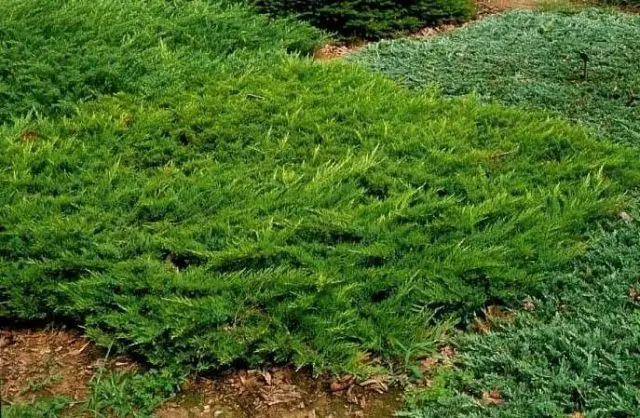
Juniper Cossack Blue Danub
The translation of the variety name Blue Danub sounds like the Blue Danube. Bred in Austria by L. Wesser, and entered for sale without a name. The name was given to the variety only in 1961.
It is a creeping shrub with outstretched and bent upward branches, similar to flames. An adult plant reaches a height of 1 m and grows to a diameter of 5 m. The crown is dense. The needles on young shrubs are needle-like, becoming scaly with age, only inside the juniper remains prickly. It grows rapidly, adding about 20 cm annually.
The color of the needles is bluish, in the shade and inside the bush – grayish. It is recommended to plant this Cossack juniper in a large flower bed or large areas, as it quickly captures a large area. Winter hardiness is high, it can grow in the sun and in partial shade.
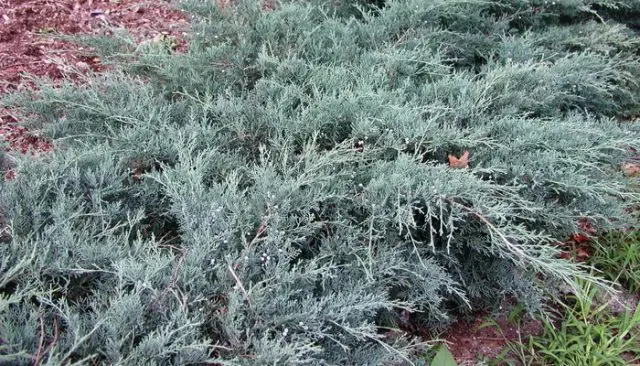
Juniper Cossack Tamariscifolia
This variety has been known since 1730. It got its name due to the fact that young shoots vaguely resemble tamarisk. Forms a prostrate shrub with straight branches raised at an angle. The crown of an adult plant is like a dome.
Young juniper has needle needles, 50 cm high and up to 2 m in diameter. After 20 years, specimens stretch up to 1-1,5 m and spread to 3-3,3 m. The needles are green.
A significant disadvantage of the variety is the tendency to dry out adult branches.
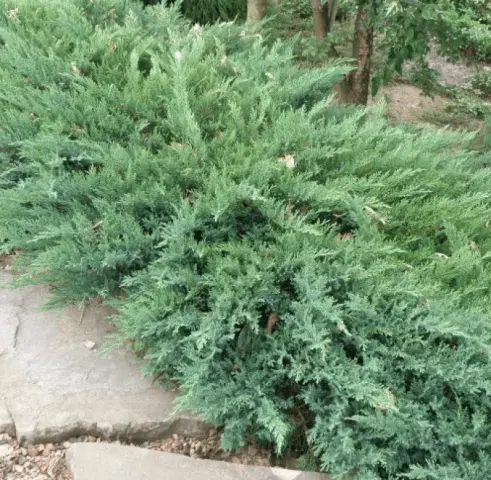
Juniper Cossack Variegata
A slowly growing form, reaching a height of 10 cm by the age of 40, a width of about 1 m. With age, it can stretch up to 1 m and reach a width of 1,5 m. The shoots are horizontally spread, the ends are raised. This juniper is notable for its cream-colored growth. Grows slowly. It tolerates low temperatures well, but the variegated tips of the branches are prone to freezing.
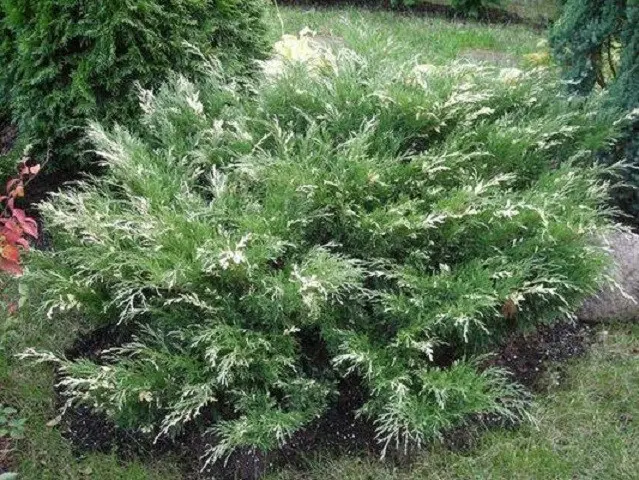
Juniper Cossack in landscape design
Types and varieties of junipers, including Cossack, are widely and willingly used in landscaping. The culture is undemanding to watering and soil composition, tolerates urban conditions well. The greatest decorativeness can be achieved if we take into account the preferences of each variety for illumination, otherwise the crown loses its shape, and the needles take on a sick look and a grayish tint.
The use of Cossack junipers in landscape design is due to the shape of the crown – depending on the variety, pressed to the ground or raising the ends of the shoots like flames of a fire. They are planted:
- as undergrowth in large areas and public parks;
- on rocky hills, in rockeries;
- to strengthen the slopes;
- varieties with a beautiful crown in the foreground of landscape groups;
- forms with horizontal creeping shoots as a groundcover;
- as a drapery in the background of landscape tree groups with high crowns;
- frame lawns or large flower beds;
- as part of landscape groups;
- in flower beds with flowers that do not require too much watering;
- as a drapery of a high foundation;
- shade-tolerant varieties can be placed along the dark side of the fence;
- grown in single-row wide borders;
- to fill hard-to-reach or unsightly empty spaces.
These are just examples of the use of Cossack juniper in landscape design. In fact, culture can be considered universal; it is not difficult for it to find a suitable corner in any area.
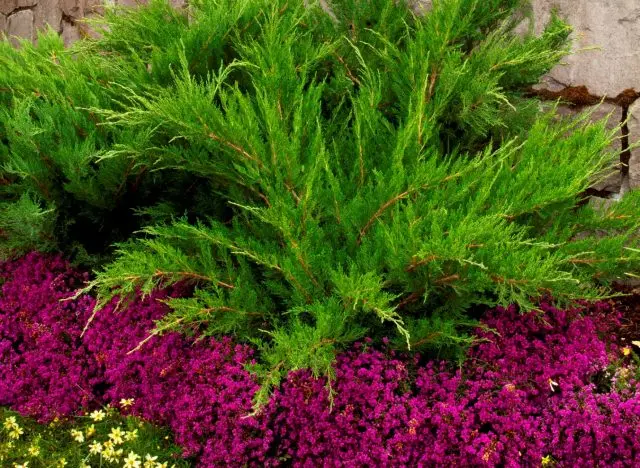
Conditions for growing juniper Cossack
Although the distribution zone of the Cossack juniper covers the southern regions, the culture perfectly tolerates low temperatures, and many varieties can be planted in zone 2. Shrubs will grow on stones, sandstones, clay and calcareous soils, and are generally undemanding to the composition of the soil.
In general, the species is photophilous, but most varieties tolerate penumbra perfectly, although they somewhat lose their decorative effect. Some forms are specially designed for growing in areas where the sun rarely looks.
Cossack juniper tolerates anthropogenic pollution well and is drought-resistant.
Planting and caring for Cossack juniper
In the care of the Cossack juniper is simple. It can be planted in infrequently visited areas and in hard-to-reach places where the plants are known not to receive much care.
The shrub needs only sanitary pruning, but if necessary, it easily tolerates a shaping haircut.
Seedling and planting preparation
Since the species is undemanding to soils, the soil in the planting pit can not be changed. If it is very bad, the mixture is prepared from peat, turf and sand. A drainage layer with a thickness of at least 15-20 cm is required. When groundwater comes close to the surface, it should be large.
A landing hole is dug at least 2 weeks in advance, drainage is laid and covered with a substrate. Abundantly watered. The depth of the pit is not less than 70 cm, the diameter depends on the volume of the earthen coma, and should exceed it by 1,5-2 times.
It is better to buy seedlings in local nurseries. Imported ones must be in containers, domestic ones can have an earthen clod lined with burlap. You can not buy junipers with a dry root or needles that have lost turgor. Branches should be carefully examined to identify damage, signs of disease and pests.
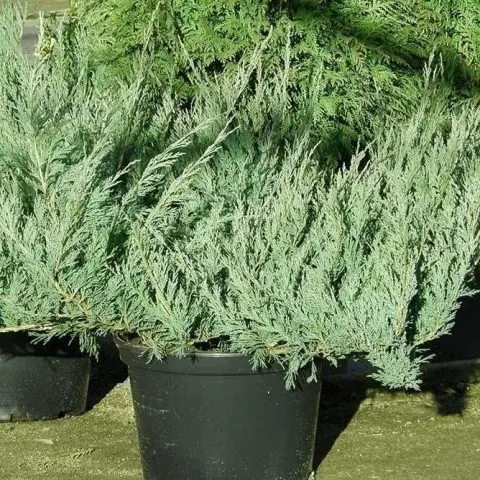
How to plant juniper Cossack
The crop can be planted in spring and autumn. Container plants – all season except hot months. Planting Cossack juniper in spring is preferable in the northern regions, in autumn – in the south. Then the culture will have time to take root well.
The planting rules imply that the bush will be placed in the hole to the same depth as it grew in the container or nursery, without deepening the root collar. The soil is constantly compacted so that voids do not form. After planting, the plant is watered abundantly, and the soil under it is mulched.
Cossack juniper transplant
It is necessary to transplant the culture in the north in the spring, in the southern regions – by the end of the season. They dig a bush together with an earthen clod, place it on a sackcloth, transfer it to a new place to a prepared pit. When some time must pass between the removal of the juniper from the ground and planting, the root is protected from drying out.
The operation itself is no different from that described in the previous chapter.
Watering and top dressing
It is necessary to water the Cossack juniper in regions with a temperate climate several times a season. During hot summers or when there is no rain for a long time, it may be necessary to humidify twice a month. Crown sprinkling is carried out in the evening, at least once a week.
It is advisable to feed the bush twice a season:
- in spring, complex fertilizers with a high nitrogen content;
- in late summer or early autumn – phosphorus-potassium top dressing.
Often, gardeners fertilize the crop only in the spring. This is allowed, but it is still better to do two dressings.
Mulching and loosening
The soil is loosened only under young plants. Then they limit themselves to mulching the soil – this does not injure the roots, retains moisture and creates a suitable microclimate.
Shelter of Cossack juniper for the winter
Cossack juniper tolerates low temperatures well. It grows low, if the winter is snowy, then the bush will not need protection even in a region with winters more severe than indicated in the varietal description.
In the first year after planting, the culture is covered with a cardboard box or white agrofiber or spunbond. In the future, the soil under the Cossack juniper is mulched in winter.
What to plant next to the Cossack juniper
Here, first of all, it should be noted cultures that cannot be planted close to the Cossack juniper. Rust often develops on the conifer. A fungus from the genus Gymnosporangium itself does not cause much harm to the juniper, but fruit crops, especially pears and plums, are very striking. Here the conifer acts as an intermediate host when carrying the disease.
Ornamental crops are planted next to the Cossack juniper such that they have similar needs for irrigation, soil composition and illumination. The choice of plants is huge, so that landscape designers and owners can create any composition.
The combination of Cossack juniper with such crops would be ideal:
- roses;
- screams;
- ferns with light fronds;
- cereals;
- bulbous;
- mosses and lichens.
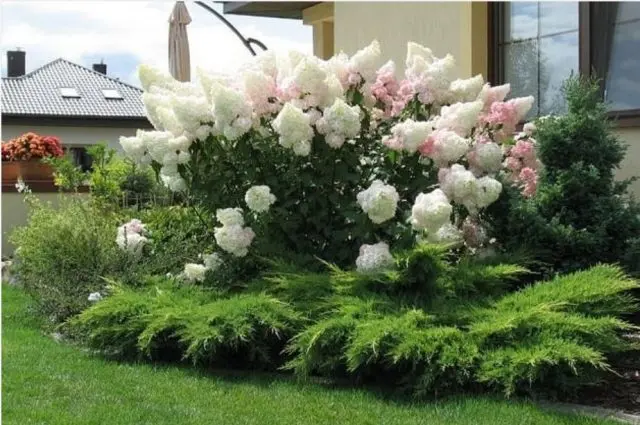
Flowering juniper Cossack
Cossack juniper is a monoecious plant, prone to dioeciousness. This means that the culture of male and female flowers on each individual specimen are unevenly located. There are individuals that have organs of seed reproduction of only one sex.
The male flower is an oval-shaped earring with many stamens, the female one is collected in a cone with 4-6 scales. Their opening and pollination occurs in May. The fruits are called cones and ripen at the end of the first season or in the spring of the next.
Black-brown, appearing bluish-gray due to plaque, the fruits are poisonous. They have a round-oval shape, size 5-7 mm, do not open when ripe. Each contains up to 4 seeds.
The flowering period of the Cossack juniper does not add decorativeness to the plant. But mature cones are a real decoration, but you can’t eat them, and you need to watch children especially carefully. Although the toxicity of the culture is low, for a fragile organism this may be enough.
How to propagate Cossack juniper
Species Cossack juniper is easy to propagate with stratified and peeled seeds. Varieties rarely inherit the properties of the mother plant, so such breeding does not make sense for amateurs.
When only a few new bushes are needed, Cossack juniper is easy to propagate by layering – its shoots themselves fall to the ground and take root. But if you “tear off” the grown branch from the ground (it is difficult to do this carefully), many roots will be torn off, it will be difficult for the plant to take root in a new place.
So it is better to manage the process on your own – choose a suitable shoot, fix it in a convenient place, sprinkle it with earth. To make it more convenient to dig up the layering, you can put pine bark, cardboard, a piece of roofing material under the part of the branch free from soil. Then it will do without unnecessary injuries – roots in an unnecessary place simply will not form.
Reproduction by cuttings of the Cossack juniper is carried out in cases where you need to get a lot of plants at once, or if someone “shared” a sprig of the variety they liked. The procedure is simple, although it requires careful attention to the seedling until rooting is over.
Cuttings of the Cossack juniper can be carried out at any time, but it is better to breed in the spring. From a bush at the age of 8-10 years, a shoot of 10-12 cm is taken with a “heel” (a piece of bark of the older branch), the lower part is freed from needles, treated with heteroauxin or another stimulant.

In a light nutrient mixture, perlite or clean coarse sand, the cuttings are planted at an angle of 30-45 °. You can not stick shoots into the substrate, holes are made with a pencil or a specially planed stick.
The soil is compacted with fingers, watered, cover the container with a film. The container must necessarily contain drainage and holes for the outflow of excess water. Landing should be regularly ventilated, instead of watering, spray abundantly from a spray bottle. Contain cuttings of the Cossack juniper in a place protected from the sun at a temperature of 16-19 °. Already at 25 ° problems can begin.
After 30-45 days, the cuttings will take root and they can be planted in separate cups with light but nutritious soil. Young Cossack junipers are moved to a permanent place after 2 years.
Pests and diseases of the Cossack juniper
Cossack juniper is a healthy culture. If you do not make mistakes in care and regularly carry out preventive treatments, use a sterile tool when trimming and carrying out sanitary measures, there should be no problems. Sometimes:
- If you ignore the sprinkling of the crown and dry air, a spider mite may appear.
- Overflows provoke the development of rot.
- Too high humidity is the cause of the appearance of mealybugs.
It should be borne in mind that it is more difficult to fight diseases and pests on young plants and forms with sharp needles. When processing, you need to literally pour the bush with a preparation so that the solution gets into the sinuses of hard, angled needles. It is there that pathogens remain, which are destroyed by fungicides, and pest larvae. Insecticides will help to cope with them.
Conclusion
Cossack juniper is an unpretentious ornamental crop that can be planted in low-maintenance gardens. In many areas, it does not occupy a dominant position, and is often not very noticeable. But if the Cossack juniper is removed from the site, it will become less decorative, lose some of its charm.
